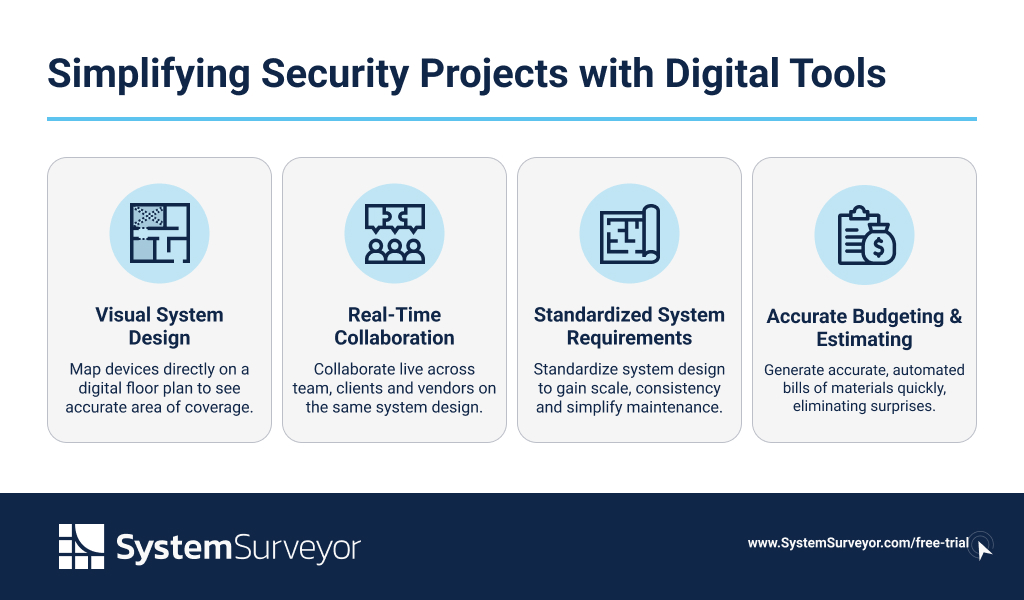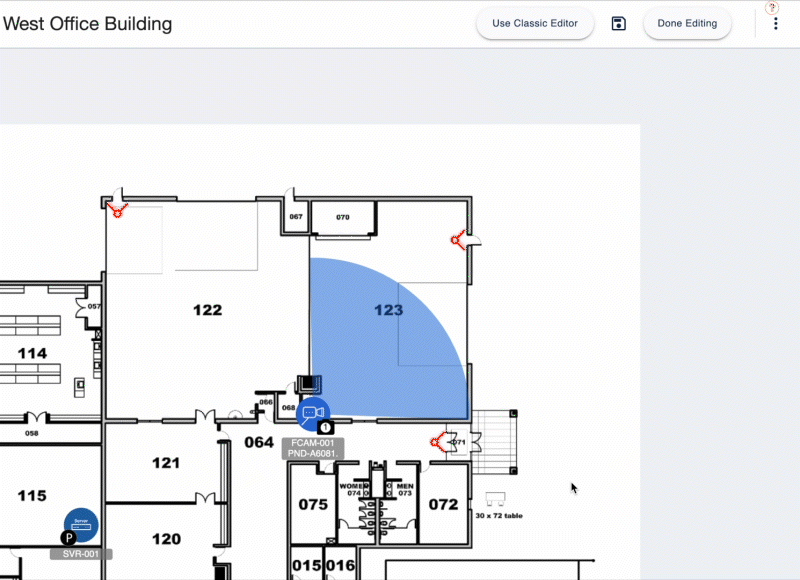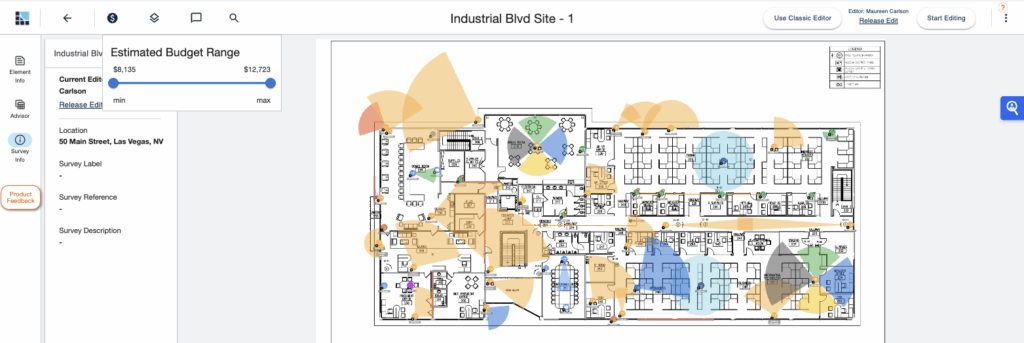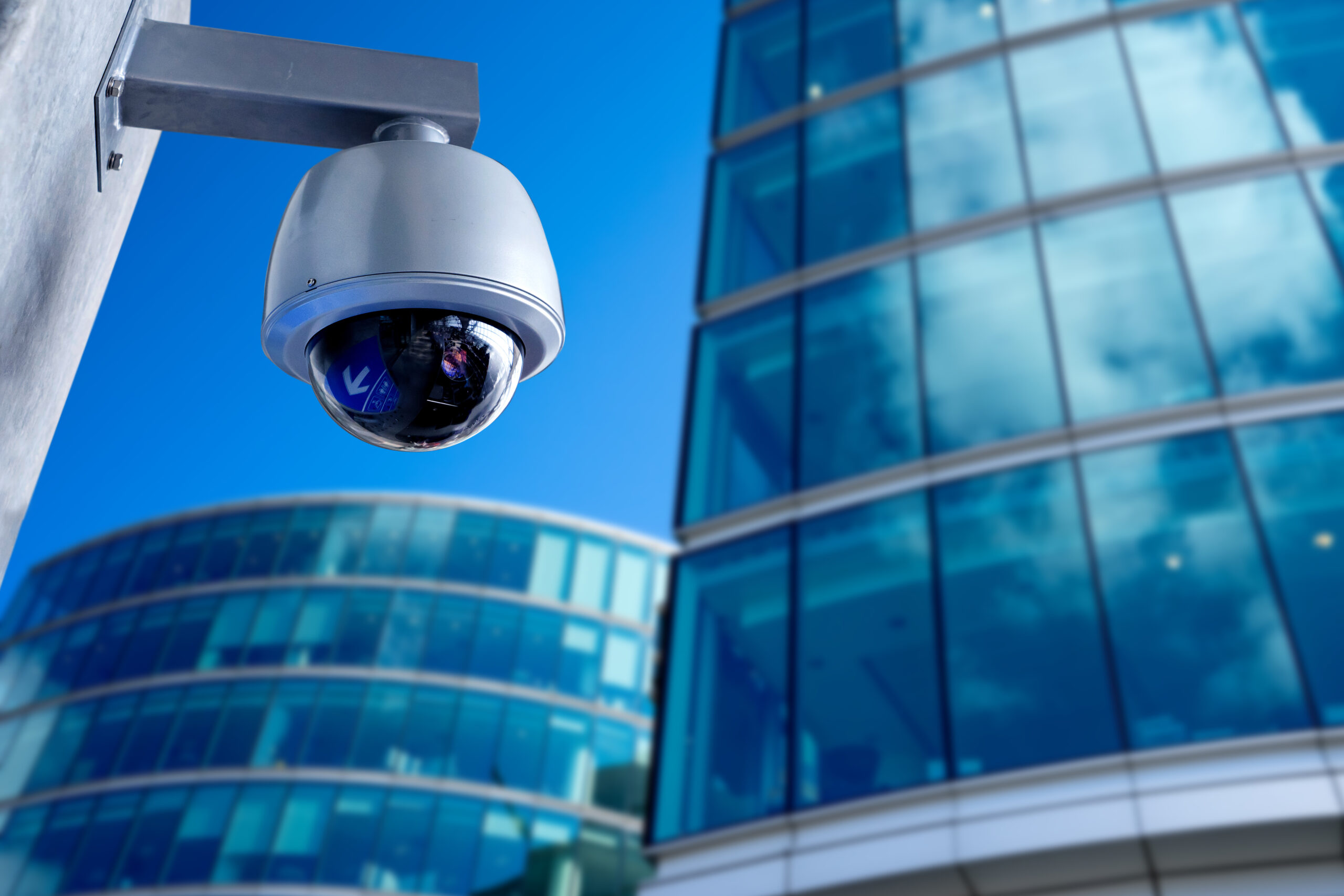Avoid delays, reduce change orders & align teams for the entire lifecycle
Often when people think about corporate security, they go straight to cybersecurity. As it turns out, physical security plays an equally critical role. The lifecycle management of security system devices—video surveillance, access control, sensors, intrusion detection, and more—is essential for businesses and organizations with sprawling physical locations: warehouses, offices, retail outlets, manufacturing sites, transportation hubs, and beyond. It’s not uncommon for annual budgets to reach into the millions just to update, refresh, and expand these technologies. With the global AI camera market projected to surge to $47 billion by 2030, growing at a 21.6% CAGR, investments in intelligent visual surveillance are clearly on the rise.
Within the System Surveyor community, many global physical security managers oversee dozens or even hundreds of dispersed sites, managing thousands of devices essential to protecting people and property—a responsibility that demands precision and focus. It’s no small job.
Enterprise and large organizations frequently manage multiple locations and formats, each with its own physical footprint, risk profile, and compliance requirements.
So how do the most effective teams consistently get it right?
Why Managing Physical Security Projects at Scale is So Complex
Delivering physical security system projects on-time, on-budget and on-going isn’t easy. It is not only the new retrofits and installs that need attention, it is a complete system lifecycle. And if you’re managing dozens of sites and multiple vendors, the complexity rises quickly—and so do the expectations of executives and stakeholders.
The location-specific nature of physical security remains one of the biggest drivers of complexity. Chad Leedy of Interface Systems puts it this way:
“Even if there’s a semblance of a standard footprint, no two locations are identical. Space constraints, floor plans, and other variances require individual attention. This lack of uniformity can pose significant challenges when integrating physical security solutions.”
Corporate security leaders are feeling pressure on all fronts, always looking for ways to reduce costs, eliminate delays, and prove ROI.
Corporate security leaders also have to navigate:
- Miscommunication between corporate and local teams when expectations and on-the-ground reality conflict.
- Inconsistent or non-existent site documentation.
- Vendor coordination chaos leads to duplicate work and costly delays.
- Change orders and cost overruns.
It is not uncommon for a large corporation to have budgets of $500,000 to $3 million per initiative for a major refresh or update to a video surveillance or access control system
Top Reasons Physical Security Projects Fail—and How to Avoid Them
Physical security projects are as unique as the locations you’re securing. But the reasons behind failed projects tend to be pretty consistent. Our top 5:
- Poor project scoping leads to vendor misquotes, failure to meet expectations, and costly rework.
- Lack of visual design leaves the installation process hazy.
- Manual documentation leads to overlooked details and errors.
- Change orders pile up due to increasing inaccuracy, costing 10–20% or more of the total budget.
- Missed timelines affect compliance, safety, and operational continuity.
- Institutional knowledge is owned by few and is not always well documented.
All of these challenges can be greatly reduced — or even solved completely — by redefining system design processes around a digital system design and lifecycle platform built for this purpose.
Importance of a Reliable, Living Digital A-Built
Another critical factor in long-term success is the availability of a reliable digital as-built. Security systems are not static—they evolve as buildings, technologies, and risks change. Without a current, centralized record of the system design, organizations face gaps in maintenance, higher costs during upgrades, and unnecessary downtime when troubleshooting. A digital as-built ensures that every component, connection, and configuration is accurately documented and always accessible. This becomes the foundation for effective lifecycle management, enabling teams to maintain, expand, and modernize security systems with confidence and efficiency.
How Digital System Design Tools Eliminate Uncertainty in Security Projects
Much of the difficulty in managing large-scale security system projects comes down to one central element: uncertainty. This uncertainty can take many forms—unknowns, limited information, location-specific variables, delays, shifting dependencies, and all the other factors we’ve explored.
If uncertainty is the challenge that unsettles a project, then a well-designed digital security system tool can serve as the stabilizing force that brings clarity and confidence. If nearly a $1M is being spent to refresh a security system, it makes sense for 5-10% spend on the software and tools to support it.

1. Visual system design to get clear on the security posture
All physical security systems are based on real-world needs and physical dimensions. Defining those in a text-heavy PDF, spreadsheet or Word document just doesn’t give corporate security leaders the tools to do so clearly.
But with a visual system design and digital map, all parties can see everything implemented directly on a floor plan of the site: access control hardware, video surveillance cameras, intrusion detection systems, sensors, and all the behind-the-scenes wiring and equipment necessary to make it all work.
One of the most important visuals is the area of coverage for video surveillance cameras or intrusion detection systems. Without a visual to show this coverage, it is hard to get the proper understanding and budget for the technology. The ability to show walls, boundaries or other impacts to the true view of cameras is helpful to get to the right solution and security devices needed to do the job. Helping your decision makers with visuals to understand the security posture is impactful.

2. Real-time collaboration
A cloud-based digital platform also enables collaboration between teams, vendors, and others. Administrators and physical security leaders can invite team members, system integrators, manufacturer, guarding, monitoring and public safety, as well as anyone else with skin in the game to collaborate on the project. All can work together on a single system design and see one another’s updates in real time. For large-scale projects involving multiple integrators and manufacturers, this level of collaboration brings clarity to the chaos.
A typical corporate physical security team works with several and sometimes many security integrators in order to serve their various geographic locations. While that is to be expected, the corporate physical security manager wants more control.
3. Standardized system requirements
Increasingly, Fortune 500 companies with hundreds of locations will standardize on access control or video surveillance systems and VMS systems in order to get economies of scale and to make processes more consistent.
Standardized solutions can help teams avoid starting from scratch each time and can limit those unique elements to the ones that truly need to be unique. This allows them to use similar templates and bills of material to help make lifecycle maintenance easier.
4. Accurate budgeting and estimating
Corporate buyers work on longer lead times and budgeting and estimating are paramount. It leaves a lot to be desired to do this purely based on the last budget cycle.
A digital system design platform can also help with budgeting: because you gain confidence that a system design is truly accounting for every needed piece of hardware and support infrastructure, you can budget with that same level of accuracy before you ever issue a purchase order. The ability to show on a map the area of coverage of video surveillance cameras or intrusion detection and any gaps is a game changer as it relates to project phases or vital budget requirements to meet the right security posture.
System Surveyor offers a budget estimator feature that includes device pricing and labor estimates to look more holistically at a project. With accurate per-line-item pricing built into your system design, you can generate a system layout and automated bill of materials even in the earlier stages of a project or at time of procurement. It reduces surprises for what can be accomplished at certain budget levels.

Providing Significant Value and Empowering Global Physical Security Teams
A digital system design platform empowers security teams as well, delivering real value and ROI.
Your teams gain an advantage with more effective, less chaotic site surveys and better communication and collaboration with vendors. You also save significant time, money, and resources thanks to fewer site visits and less rework.
And perhaps the most important of all: with a digital system design platform, you can move more quickly, making better decisions faster.
For corporate security leaders, System Surveyor delivers measurable returns by cutting waste, increasing efficiency, and improving long-term system performance.
- Realize over 50x ROI, with proven cost savings and operational improvements across multi-site deployments.
- Improve project efficiency by 40%, streamlining design, documentation, and vendor coordination.
- Ensure accuracy with a cloud-based digital as-built, reducing downtime and accelerating upgrades or expansions.
- Enhance vendor accountability and stakeholder trust, driving more predictable outcomes and improved compliance.
- Strengthen long-term resilience and credibility by maintaining a living system-of-record that scales with the organization.
Deliver Security Projects On Time, On Budget & Without Rework
Corporate security leaders can go beyond even these benefits, leveraging a digital design platform into consistent ongoing success.
- Executive trust: CFOs and CISOs expect accuracy, accountability, and agility throughout the business — and that includes physical security. The fact that the status quo has been less than stellar on those three fronts isn’t likely to have much sway, especially now that there’s a better way.
- Buy-in: Physical security is vital, but not exactly sexy. Corporate security leaders also have to achieve internal buy-in, which is far easier to do with the clear and consistent documentation achievable with a digital system design tool.
- Future success: Discuss with corporate security leaders the benefits that a digital platform offers beyond the obvious (on-time, on-budget projects). It sets them up for consistent success in the future.
- Responsiveness: Visual planning tools make corporate security leaders more agile, enabling them to respond accurately to precise internal feedback and course-correct early.
Operational control: Put it all together, and the result is remarkable: security leaders reclaim operational control of physical security projects and gain strategic credibility with their stakeholders.
Move from Chaos to Control in Your Global Security Projects
It’s time to adjust the approach to thinking about physical security projects. They aren’t one-off events anymore; instead, they’re ongoing strategic investments that need both precision and repeatability.
Getting this right consistently means standardizing design where possible, communicating clearly both internally and externally, and proactive planning that’s both detailed and accurate.
Tools like System Surveyor help corporate security leaders move from chaos to clarity: with collaborative cloud-based system designs, it’s possible to build more accurate system designs more quickly, leading to greater efficiency, less cost, and safer outcomes.
Frequently Asked Questions about Delivering Projects On-Time and On-Budget
1. What are the biggest risks that put security projects over budget or behind schedule?
The most common challenges in physical security system design include poor scoping, unclear requirements, reliance on manual documentation, and late-stage change orders. Each of these issues can drive costs up by 10–20% and push timelines back weeks or even months. The key to designing and implementing a security system on-time and on-budget is better up-front visibility and tighter collaboration from the start.
2. How do change orders impact project outcomes?
Change orders don’t just add cost—they undermine trust and stall progress with security system design and installation. When stakeholders discover misalignments late in the process, it often leads to rework, confusion, and strained vendor relationships. Using a security system design tool with built-in accuracy and transparency minimizes the likelihood of costly revisions.
3. What role does a “digital as-built” play in long-term success?
A digital as-built serves as a living record of your physical security system design. Every camera, cable, sensor, and connection is documented visually and updated in real time. This eliminates the “mystery gap” between design and installation, making system maintenance, upgrades, and troubleshooting faster and more reliable.
4. How do digital system design tools remove project uncertainty?
Digital tools bring clarity through:
- Visual system design—mapping cameras, sensors, wiring, and coverage directly onto floor plans.
- Real-time collaboration—enabling corporate teams, vendors, integrators, and other stakeholders to work seamlessly together.
- Standardized system templates—promoting consistency and efficiency across sites.
- Accurate budgeting and estimating—leveraging built-in pricing and bill-of-materials to reduce surprises and enable proactive decision-making
5. What kind of ROI and efficiency gains can security leaders expect?
Teams often see a 40% acceleration in project delivery, over 50× ROI, and far fewer delays. By reducing manual errors, ensuring consistent documentation, and streamlining stakeholder communication, corporate security leaders not only deliver on-time and on-budget but also build a scalable foundation for future security system projects.
6. How does System Surveyor specifically help corporate tech leaders succeed?
System Surveyor provides a visual, collaborative design platform built for physical security system projects. Corporate security and IT leaders use it to:
- Standardize physical security system designs across multiple sites.
- Scope and budget accurately with built-in templates and automated bills of materials.
- Collaborate in real-time digital as-builts for ongoing operations and system life cycle maintenance.
- Reduce rework, minimize change orders, and build accountability with vendors.
